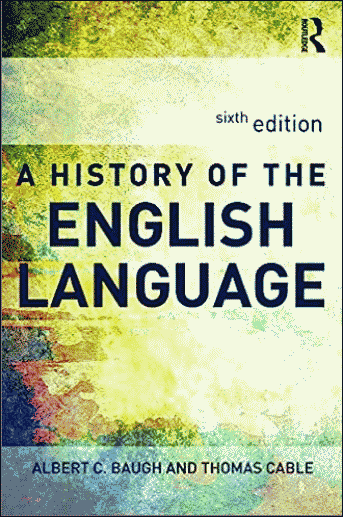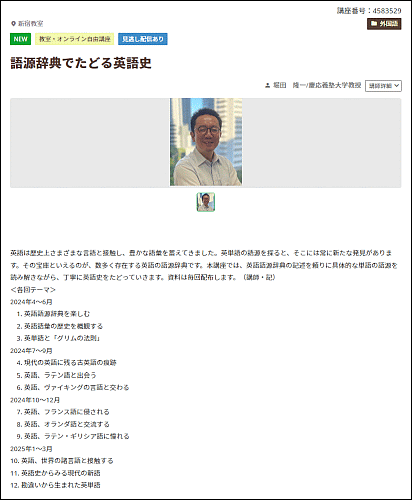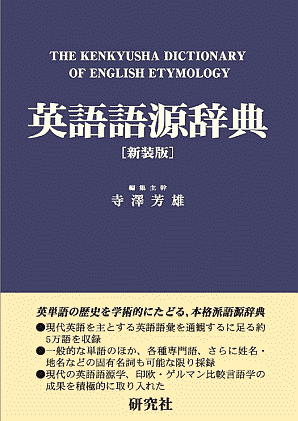2024-09-21 Sat
■ #5626. 古英語の sc の口蓋化・歯擦化 (2) [sound_change][phonetics][consonant][palatalisation][oe][digraph][spelling][alliteration][aelfric]
以前に「#1511. 古英語期の sc の口蓋化・歯擦化」 ([2013-06-16-1]) で取り上げた話題.古英語の2重字 (digraph) である <sc> について,依拠する文献を Prins に変え,そこで何が述べられているかを確認し,理解を深めたい.Prins (203--04) より引用する.
7.16 PG sk
PG sk was palatalized:
1. In initial position before all vowels and consonants:
OE Du sčēap 'sheep' schaap WS sčield A scčeld 'shield' schild sčēawian 'to show' schouwen G schauen sčendan 'to damage' schenden sčrud 'shroud'
2. Medially between palatal vowels and especially when followed originally by i(:) or j:
þrysče 'thrush'
wysčean 'to wish'
3. Finally after palatal vowels:
æsč 'ash'
disč 'dish'
Englisč 'English'
古英語研究では通常,口蓋化した <sc> の音価は [ʃ] とされているが,Prins (204) の注によると,本当に [ʃ] だったかどうかはわからないという.むしろ [sx] だったのではないかと議論されている.
Note 2. In reading OE we generally read sc(e) as [ʃ], but there is no definite proof that this was the pronunciation before the ME period (when the French spelling s, ss is found, and the spelling sh is introduced).
In Ælfric sc alliterates with sp, and st. So s must have been the first element. The second element cannot have been k, since Scandinavian loanwords (which must have been adopted in lOE) still have sk: skin, skill.
The pronunciation in OE was probably [sx]. Cf. Dutch schoon [sxo:n], schip [sxip], which in the transition period to eME or in eME itself, must have become [ʃ].
・ Prins, A. A. A History of English Phonemes. 2nd ed. Leiden: Leiden UP, 1974.
2024-09-18 Wed
■ #5623. 「英語史ライヴ2024」で B&C の第57節 "Chronological Criteria" を対談精読実況生中継しました [bchel][latin][borrowing][methodology][sound_change][palatalisation][loan_word][oe][chronology][lexicology][phonetics][hellive2024]
一昨日の Voicy heldio にて「#1205. Baugh and Cable 第57節を対談精読実況生中継 --- 「英語史ライヴ2024」より」をアーカイヴ配信しました.これは「#5607. 「英語史ライヴ2024」で B&C の第57節 "Chronological Criteria" を対談精読実況生中継します」 ([2024-09-02-1]) で予告したとおり,9月8日(日)に開催された「英語史ライヴ2024」の早朝枠にて生配信された番組がもとになっています.
金田拓さん(帝京科学大学)がメインMCを務め,小河舜さん(上智大学)と私が加わる形での対談精読実況生中継でした.ヘルメイト(helwa リスナー)や khelf メンバーも数名がギャラリーとして収録現場に居合わせ,生配信でお聴きになったリスナーものべ81名に達しました.たいへんな盛況ぶりです.皆さん,日曜日の朝から盛り上げてくださり,ありがとうございました.
今回取り上げたセクションは,実はテクニカルです.古英語期のラテン借用語について,それぞれの単語が同時期内でもいつ借りられたのか,いわば借用の年代測定に関する方法論が話題となっています.取り上げられているラテン借用語の例はすこぶる具体的ではありますが,音変化の性質や比較言語学の手法に光を当てる専門的な内容となっています.
しかし,今回の対談精読会にそってに丁寧に英文を読み解いていえば,必ず理解できますし,歴史言語学研究のエキサイティングな側面を体験することもできるでしょう.本編48分ほどの長尺ですが,ぜひお時間のあるときにゆっくりお聴きください.
Baugh and Cable の精読シリーズのバックナンバー一覧は「#5291. heldio の「英語史の古典的名著 Baugh and Cable を読む」シリーズが順調に進んでいます」 ([2023-10-22-1]) に掲載しています.ぜひこの機会にテキストを入手して,第1節からお聴きいただければ.

・ Baugh, Albert C. and Thomas Cable. A History of the English Language. 6th ed. London: Routledge, 2013.
2024-09-14 Sat
■ #5619. 9月28日(土)の朝カル新シリーズ講座第6回「英語,ヴァイキングの言語と交わる」のご案内 [asacul][notice][kdee][etymology][hel_education][helkatsu][link][lexicology][vocabulary][oe][old_norse][germanic][contact][voicy][heldio]

・ 日時:9月28日(土) 17:30--19:00
・ 場所:朝日カルチャーセンター新宿教室
・ 形式:対面・オンラインのハイブリッド形式(見逃し配信あり)
・ お申し込み:朝日カルチャーセンターウェブサイトより
2週間後の9月28日(土)17:30--19:00に朝日カルチャーセンター新宿教室にてシリーズ講座「語源辞典でたどる英語史」の第6回となる「英語,ヴァイキングの言語と交わる」を開講します.
前回8月24日の第5回では「英語,ラテン語と出会う」と題して,古英語期(あるいはそれ以前の時代)におけるラテン語の語彙的影響に注目しました.今回は8世紀後半から11世紀前半にかけてのヴァイキング時代に焦点を当て,古ノルド語 (old_norse) と古英語の言語接触について解説します.
ヴァイキングとは上記の時期に活動したスカンジナビア出身の海賊を指します.彼らはブリテン島にも襲来し,やがてイングランド東部・北部に定住するようになりました.その結果,古ノルド語を母語とするヴァイキングと古英語を話すアングロサクソン人との間で言語接触が起こりました.
古ノルド語からの借用語は,現代英語に900語ほど残っています.この絶対数はさほど大きいわけではありませんが,基本語や機能語など高頻度で使用される語が多く含まれているのが注目すべき特徴です.講座では具体的な古ノルド語からの借用語を取り上げ,その語源を読み解いていきます.
古ノルド語と英語の接触は非常に濃密なものでした.これは両言語がゲルマン語族に属しており,近い関係にあったことや,両民族の社会的な交流の深さを反映していると考えられます.ヴァイキングの活動を通じた古ノルド語との接触は,英語の語彙に(そして実は文法にも)多大な影響を与えました.現代英語の姿を理解する上で,この歴史的な言語接触の重要性は看過できません.
本シリーズ講座は各回の独立性が高いので,第6回からの途中参加でもまったく問題なく受講できます.新宿教室での対面参加のほかオンライン参加も可能ですし,その後1週間の「見逃し配信」もご利用できます.奮ってご参加ください.お申し込みはこちらよりどうぞ.
なお,本シリーズ講座は「語源辞典でたどる英語史」と題しているとおり,とりわけ『英語語源辞典』(研究社)を頻繁に参照します.同辞典をお持ちの方は,講座に持参されると,より楽しく受講できるかと思います(もちろん手元になくとも問題ありません).

(以下,後記:2024/09/21(Sat))
・ 寺澤 芳雄(編集主幹) 『英語語源辞典』新装版 研究社,2024年.
2024-09-12 Thu
■ #5617. 「古英語LINEスタンプ」をリリース --- アングロサクソン戦士 Winewulf くんとともに古英語の挨拶を楽しもう! [oe][hellive2024][ole_english_stickers][winewulf][khelf][calligraphy][alphabet][greetings]

今回はとてもエキサイティングなお知らせです.heldio/helwa で企画立案された「古英語LINEスタンプ」が,有志の手により完成しました.先日9月8日の「英語史ライヴ2024」の正午の番組にてお披露目となりましたが,そのときには皆でその場で当該スタンプを購入し,オープンチャット「古英語スタンプお試し会」にてスタンプを交わし合うというイベントも実施しました.ぜひ皆さんも「古英語スタンプ」をご覧になり,よろしければ入手して日常的にお使いください.
メインキャラ Winewulf くん
このスタンプのメインキャラクターはアングロサクソン戦士 Winewulf (ウィネウルフ)くんです.その名は古英語で「友の戦士(狼)」を意味します.彼は勇敢で心優しいアングロサクソンの戦士です.槍と盾を持ち,赤いマントをなびかせた頼もしい戦士の姿ですが,それでいて親しみやすい表情が特徴です.母語である古英語を織り交ぜながら,皆さんのトークに英語史の風を吹き込んでくれます.
上記のイラストでは,Winewulf くんは Ic eom Winewulf 「私はウィネウルフです」と自己紹介をしています.スタンプでは,他の日常使いできる挨拶や感謝の気持ちを母語の古英語で発しています.例えば「おはよう」の意味で Godne morȝen を,感謝の気持ちを込めて Ic ðancie ðe を唱えています.英語史好きの方にはぴったりのスタンプです!
「古英語LINEスタンプ」の試み
「古英語LINEスタンプ」の制作は,他に類を見ない本気の試みでした.スタンプに使用されている古英語の文言は,古英語研究者である小河舜さん(上智大学)と khelf の藤原郁弥さん(慶應義塾大学大学院生),および私自身も補佐的に監修しました.そして,その文言は,古英語の代表的な書体である "Insular Minuscule" で綴られており,まるで中世の古文書を手に取るような感覚を味わえます.日本語訳も付されていますので,大丈夫.日常遣いできます.
こんなシーンで使えます!
・ 友達との日常会話に英語史的なアクセントを加えたいとき
・ 言語 and/or 歴史に興味のある仲間とユニークなやり取りを楽しむ場面で
・ 普段の挨拶や感謝の気持ちを,特殊な言語・文字で伝えてみたいとき
・ Winewulf くんを人気キャラに成長させるために!
古英語の魅力を伝える Winewulf くんの「古英語スタンプ」を使って,いつものトークが一気に特別なものに変わるでしょう.Winewulf くんと一緒に友達や家族とのコミュニケーションを楽しんでみませんか? 他に例のない本格的なスタンプで,メッセージに英語史の深みを加えてください!
入手はこちらからどうぞ
「古英語スタンプ」は,LINEストアにて好評発売中です.最低金額に設定しています.Winewulf くんが登場するスタンプ8個のセットは,古英語文言とキャラ・デザインの両方を楽しめる一品です.ぜひチェックしてみてください!
イラストレーターと監修者への感謝
スタンプのイラストレーターは,heldio の有料版,プレミアムリスナー限定配信チャンネル「英語史の輪」 (helwa) の有志リスナーお二方,Lilimi さんと MISATO (Galois) さんです.監修の小河舜さんと藤原郁弥さんを含め,制作班の皆の尽力に感謝いたします.
2024-09-02 Mon
■ #5607. 「英語史ライヴ2024」で B&C の第57節 "Chronological Criteria" を対談精読実況生中継します [bchel][latin][borrowing][methodology][sound_change][palatalisation][loan_word][oe][chronology][lexicology][phonetics][hellive2024]

Baugh and Cable による英語史の古典的名著を Voicy heldio にて1節ずつ精読していくシリーズをゆっくりと進めています.昨年7月に開始した有料シリーズですが,たまの対談精読回などでは通常の heldio にて無料公開しています.
9月8日(日)に12時間 heldio 生配信の企画「英語史ライヴ2024」が開催されますが,当日の早朝 8:00-- 8:55 の55分枠で「Baugh and Cable 第57節を対談精読実況生中継」を無料公開する予定です.金田拓さん(帝京科学大学)と小河舜さん(上智大学)をお招きし,日曜日の朝から3人で賑やかな精読回を繰り広げていきます.
テキストをお持ちでない方のために,当日精読することになっている第57節 "Chronological Criteria" (pp. 73--75) の英文を以下に掲載しておきます.古英語期のラテン借用語の年代測定に関するエキサイティングな箇所です.じっくりと予習しておいていただけますと,対談精読実況生中継を楽しく聴くことができると思います.
57. Chronological Criteria. In order to form an accurate idea of the share that each of these three periods had in extending the resources of the English vocabulary, it is first necessary to determine as closely as possible the date at which each of the borrowed words entered the language. This is naturally somewhat difficult to do, and in the case of some words it is impossible. But in a large number of cases it is possible to assign a word to a given period with a high degree of probability and often with certainty. It will be instructive to pause for a moment to inquire how this is done.
The evidence that can be employed is of various kinds and naturally of varying value. Most obvious is the appearance of the word in literature. If a given word occurs with fair frequency in texts such as Beowulf, or the poems of Cynewulf, such occurrence indicates that the word has had time to pass into current use and that it came into English not later than the early part of the period of Christian influence. But it does not tell us how much earlier it was known in the language, because the earliest written records in English do not go back beyond the year 700. Moreover, the late appearance of a word in literature is no proof of late adoption. The word may not be the kind of word that would naturally occur very often in literary texts, and so much of Old English literature has been lost that it would be very unsafe to argue about the existence of a word on the basis of existing remains. Some words that are not found recorded before the tenth century (e.g., pīpe 'pipe', cīese 'cheese') can be assigned confidently on other grounds to the period of continental borrowing.
The character of the word sometimes gives some clue to its date. Some words are obviously learned and point to a time when the church had become well established in the island. On the other hand, the early occurrence of a word in several of the Germanic dialects points to the general circulation of the word in the Germanic territory and its probable adoption by the ancestors of the English on the continent. Testimony of this kind must of course be used with discrimination. A number of words found in Old English and in Old High German, for example, can hardly have been borrowed by either language before the Anglo-Saxons migrated to England but are due to later independent adoption under conditions more or less parallel, brought about by the introduction of Christianity into the two areas. But it can hardly be doubted that a word like copper, which is rare in Old English, was nevertheless borrowed on the continent when we find it in no fewer than six Germanic languages.
The most conclusive evidence of the date at which a word was borrowed, however, is to be found in the phonetic form of the word. The changes that take place in the sounds of a language can often be dated with some definiteness, and the presence or absence of these changes in a borrowed word constitutes an important test of age. A full account of these changes would carry us far beyond the scope of this book, but one or two examples may serve to illustrate the principle. Thus there occurred in Old English, as in most of the Germanic languages, a change known as i-umlaut. (Umlaut is a German word meaning 'alteration of sound', which in English is sometimes called mutation.) This change affected certain accented vowels and diphthongs (æ, ā, ō, ū, ēa, ēo , and īo) when they were followed in the next syllable by an ī or j. Under such circumstances, æ and a became e, and ō became ē, ā became ǣ, and ū became ȳ. The diphthongs ēa, ēo, īo became īe, later ī, ȳ. Thus *baŋkiz > benc (bench), *mūsiz > mȳs, plural of mūs (mouse), and so forth. The change occurred in English in the course of the seventh century, and when we find it taking place ina word borrowed from Latin, it indicates that the Latin word had been taken into English by that time. Thus Latin monēta (which became *munit in Prehistoric OE) > mynet (a coin, Mod. E. mint) and is an early borrowing. Another change (even earlier) that helps us to date a borrowed word is that known as palatal diphthongization. By this sound change ǣ or ē in early Old English was changed to a diphthong (ēa and īe, respectively) when preceded by certain palatal consonants (ċ, ġ, sc). OE cīese (L. cāseus, chesse) mentioned earlier, shows both i-umlaut and palatal diphthongization (cāseus > *ċǣsi > *ċēasi > *ċīese). In many words, evidence for date is furnished by the sound changes of Vulgar Latin. Thus, for example, an intervocalic p (and p in the combination pr) in the Late Latin of northern Gaul (seventh century) was modified to a sound approximating a v, and the fact that L. cuprum, coprum (copper) appears in OE as copor with the p unchanged indicates a period of borrowing prior to this change (cf. F. cuivre). Again Latin ī changed to e before A.D. 400 so that words like OE biscop (L. episcopus), disc (L. discus), sigel 'brooch' (L. sigillum), and the like, which do not show this change, were borrowed by the English on the continent. But enough has been said to indicate the method and to show that the distribution of the Latin words in Old English among the various periods at which borrowing took place rests not upon guesses, however shrewd, but upon definite facts and upon fairly reliable phonetic inferences.
Baugh and Cable の精読シリーズのバックナンバー一覧は「#5291. heldio の「英語史の古典的名著 Baugh and Cable を読む」シリーズが順調に進んでいます」 ([2023-10-22-1]) に掲載しています.ぜひこの機会にテキストを入手して,第1節からお聴きいただければ.
・ Baugh, Albert C. and Thomas Cable. A History of the English Language. 6th ed. London: Routledge, 2013.
2024-08-18 Sun
■ #5592. アングロサクソン人とケルト人の接触をめぐる解説 [bchel][celtic][contact][anglo-saxon][oe][heldio]

Baugh and Cable による英語史の古典的名著を,Voicy heldio にて1節ずつ精読していくシリーズ(有料)が,ゆっくりと継続中です.目下,第4章の "Foreign Influences on Old English" (古英語への他言語からの影響)に入っています.第54節と第55節は,英語史では一般に地味な扱いを受けてきたケルト語からの影響が話題とされています.今回はアングロサクソン人とケルト人の接触がいかなるものだったかを解説している第54節 "The Celtic Influence" について,その英文を掲げます.テキストをお持ちでない方も,関心があれば,この英文を参照しつつ,ぜひ「英語史の古典的名著 Baugh and Cable を読む (54) The Celtic Influence」をお聴きください(第1チャプターは無料で試聴できます).
54. The Celtic Influence. Nothing would seem more reasonable than to expect that the conquest of the Celtic population of Britain by the Anglo-Saxons and the subsequent mixture of the two peoples should have resulted in a corresponding mixture of their languages, that consequently we should find in the Old English vocabulary numerous instances of words that the Anglo-Saxons heard in the speech of the native population and adopted. For it is apparent that the Celts were by no means exterminated except in certain areas, and that in most of England large numbers of them were gradually assimilated into the new culture. The Anglo-Saxon Chronicle reports that at Andredesceaster or Pevensey a deadly struggle occurred between the native population and the newcomers and that not a single Briton was left alive. The evidence of the place-names in this region lends support to the statement. But this was probably an exceptional case. In the east and southeast, where the Germanic conquest was fully accomplished at a fairly early date, it is probable that there were fewer survivals of a Celtic population than elsewhere. Large numbers of the defeated fled to the west. Here it is apparent that a considerable Celtic-speaking population survived until fairly late times. Some such situation is suggested by a whole cluster of Celtic place-names in the northeastern corner of Dorsetshire. It is altogether likely that many Celts were held as slaves by the conquerors and that many of the Anglo-Saxons chose Celtic mates. In parts of the island, contact between the two peoples must have been constant and in some districts intimate for several generations.
一般には,アングロサクソン人はケルト人を根絶やしにした,完全制圧したなどと言われることが多いのですが,実際には征服の貫徹度は地域によっても異なっていたし,上下関係はあったとしても意外と長く共存していたのではないかということです.
一方,古英語とケルト語の言語的関係はどのようなものだったのでしょうか.それは次の第55節 "Celtic Place-Names and Other Loanwords" (ケルト語の地名と他の借用語)で取り上げられています.「英語史の古典的名著 Baugh and Cable を読む (55) Celtic Place-Names and Other Loanwords」よりどうぞ.
heldio のシリーズのバックナンバー一覧は「#5291. heldio の「英語史の古典的名著 Baugh and Cable を読む」シリーズが順調に進んでいます」 ([2023-10-22-1]) に掲載しています.
・ Baugh, Albert C. and Thomas Cable. A History of the English Language. 6th ed. London: Routledge, 2013.
2024-08-17 Sat
■ #5591. 8月24日(土)の朝カル新シリーズ講座第5回「英語,ラテン語と出会う」のご案内 [asacul][notice][kdee][etymology][hel_education][helkatsu][link][lexicology][vocabulary][oe][latin][voicy][heldio]

1週間後の8月24日(土)17:30--19:00に朝日カルチャーセンター新宿教室にてシリーズ講座「語源辞典でたどる英語史」の第5回となる「英語,ラテン語と出会う」を開講します.
前回,7月27日の第4回では「現代の英語に残る古英語の痕跡」と題して,古英語の語彙,語形成,ケルト語からの僅少な影響に注目しました.そこでは古英語が純度の高いゲルマン系の語彙を保っており,造語能力も豊かであったことを解説しました.
しかし,古英語にも諸言語からの借用語は確かにありました.少数のケルト借用語の存在についてはすでに触れましたが,その他にもラテン語語や古ノルド語からの借用語が各々数百語(以上)の規模で古英語に入ってきていたのです.数百語ほどの数では語彙全体のなかではさほど目立たないのも確かですが,その後の豊富な語彙借用の歴史を念頭におけば,古英語期が英語史上重要な位置づけにあることが理解できるでしょう.
今回の講座では,古英語期(あるいはそれ以前の時代)におけるラテン語の語彙的影響に注目します.また,ラテン語の影響が語彙的・言語的なレベルにとどまらず文化的な次元にまで及んだことにも触れます.
本シリーズ講座は各回の独立性が高いので,第5回からの途中参加などでもまったく問題なく受講できます.新宿教室での対面参加のほかオンライン参加も可能ですし,その後1週間の「見逃し配信」もご利用できます.奮ってご参加ください.
なお,本シリーズ講座は「語源辞典でたどる英語史」と題しているとおり,とりわけ『英語語源辞典』(研究社)を頻繁に参照します.同辞典をお持ちの方は,講座に持参されると,より楽しく受講できるかと思います(もちろん手元になくとも問題ありません).

・ 寺澤 芳雄(編集主幹) 『英語語源辞典』新装版 研究社,2024年.
2024-08-15 Thu
■ #5589. 古英語の間投詞 eala [oe][interjection][me][onomatopoeia][doe][latin]
現代英語の oh におおよそ相当する古英語の間投詞 (interjection) として ēalā というものがある.この語は初期中英語へも ealā として引き継がれたが,後期中英語までには死語となったようだ.一般的に間投詞はそういうものだと思われるが,見るからに(聞くからに)叫び声そのものに基づくとおぼしきオノマトペだ.ラテン語の間投詞 o に対する古英語の注釈としても用いられており,古英語では汎用的な間投詞だったといってよい.
もう少し細かくいえば,このオノマトペは2つの部分からなっており,実際にそれぞれが独立した間投詞としても用いられる.ēa と lā である.組み合わせ方や重複のさせ方も様々にあったようで,The Dictionary of Old English (DOE) によると eala ea, eala ... la, eala ... ea, eala eala, ealaeala など豊かなヴァリエーションを示す.他の間投詞と組み合わさって eala nu "oh now" のような使い方もあった.
使い方としては,古英語の例文を眺める限り,呼びかけ,懇願,祈り,嘆き,誓言,疑問,皮肉などに広く用いられており,やはり現代英語の oh に相当するといってよい.勢いとしても強めの用法から弱めの用法まであり,上記のように繰り返して用いれば感情が強くこもったのだろう.
古英語よりくどめの例文を選んでみた.
・ Lit 4.6 1: æla þu dryhten æla ðu ælmihtiga God æla cing ealra cyninga & hlaford ealra waldendra.
・ Sat 161: . . . eala drihtenes þrym! eala duguða helm! eala meotodes miht! eala middaneard! eala dæg leohta! eala dream Godes! eala engla þreat! eala upheofen!
・ HomU 38 18: eala, eala, fela is nu ða fracodra getrywða wide mid mannum.
2024-08-13 Tue
■ #5587. 古英語 niht "night" の屈折 [oe][inflection][gender][case][paradigm]
現代英語の night に対応する古英語単語は niht である.これは古英語の形態カテゴリーとしては女性強変化名詞なのだが,女性強変化名詞の多数派とは少々異なる屈折形を示す少数派のグループに属する名詞なので注意が必要である.
具体的にいえば,多数派では単数主格と単数対格とを比べるとで,後者に -e 語尾が付くという差異がみられるのだが,少数派では両者が無語尾で同形となるのである.また,少数派では,複数主格・対格が -a を取らず -e で一致する という特徴もある.
屈折表 (paradigm) を挙げるのが早いだろう.まず,女性強変化名詞の多数派に属する2つの名詞,短語根の ġiefu "gift" と長語根の lār "teaching" の屈折表を示そう.
| Sing. | Pl. | Sing. | Pl. | |
| N. | ġief-u | ġief-a, -e | lār | lār-a, -e |
| A. | ġief-e | ġief-a, -e | lār-e | lār-a, -e |
| G. | ġief-e | ġief-a, -ena | lār-e | lār-a, -ena |
| D. | ġief-e | ġief-um | lār-e | lār-um |
一方,niht のように少数派に属するものは,次の通りの屈折を示す.
| Sing. | Pl. | |
| N. | niht | niht-e |
| A. | niht | niht-e |
| G. | niht-e | niht-a, -ena |
| D. | niht-e | niht-um |
niht タイプの女性強変化名詞を他に挙げると,ǣht "property", brȳd "bride", cwē "queen", cyst "virtue", dǣd "deed", fierd "army", hǣs "command", lyft "air", miht "power", nīed "need", tīd "tide", wēn "hope", wynn "oyj", wyrd "fate", wyrt "plant" などがある.
以上 Sweet's Anglo-Saxon Primer の §§17--18 を参照した.
・ Davis, Norman. Sweet's Anglo-Saxon Primer. 9th ed. Oxford: Clarendon, 1953.
[ 固定リンク | 印刷用ページ ]
2024-08-02 Fri
■ #5576. 標準語の変遷と方言差を考える --- 日本語史と英語史の共通点 [historiography][japanese][hel][dialect][variety][diachrony][standardisation][oe][review]

今年4月に出版された日本語史の新著です.Voicy heldio の先日の配信回「#1158. 今野 真二 『日本語と漢字 --- 正書法がない言葉の歴史』 岩波書店〈岩波新書〉,2024年.」で簡単に紹介しました.
序章から重要な議論が様々に展開しているのですが,ここでは pp. 9--10 より1段落を引用します.
これまでは,奈良時代の日本語について「音声・音韻」「語彙」「統語(文法)」「文字・表記」のように,分野を分けて記述し,平安時代,鎌倉時代も同様に記述していくというやりかたがとられてきた.奈良時代,平安時代はたしかにある時間幅をもっているので,それぞれを別の「共時態」とみることはできる.しかしそれをつなげてとらえていいかどうかはわからないともいえる.なぜならば,奈良と京都では,空間が異なるからだ.つまり奈良時代の日本語と思っている日本語はいわば「奈良方言」であり,平安時代の日本語と思っている日本語はいわば「京都方言」であり,異なる方言なのだから違うのは当たり前という可能性が完全には排除されていないからだ.こうした語り方が不都合とまではいえないかもしれないが,そうしたことにも目を配る必要がある.しかし,あまりそうした配慮はなされてきていないと思われる.
この指摘は日本語史のみならず英語史にもそのまま当てはまる点で,注目に値します.英語史でも,古英語期の「標準語」はイングランド南西部のウェストサクソン方言でしたが,後期中英語期以降のそれは,イングランド南東部を基盤としつつ他の方言特徴も取り込んだロンドン方言となりました.
古英語と後期中英語の言語的差異を説明する際に,通時的な変化を思い浮かべるのが普通だと思います.しかし,比べているのが古英語のウェストサクソン方言と後期中英語のロンドン方言だということに注意する必要があります.問題の差異は,通時的変化ではなく方言差を反映している可能性があるのです.もちろん通時的変化と方言差の両方が関わっているケースも多いでしょう.ポイントは,時間軸だけではなく空間軸をも考慮しなければならないということです.これは○○語史を読む際に常に注意したい点です.
・ 今野 真二 『日本語と漢字 --- 正書法がないことばの歴史』 岩波書店〈岩波ジュニア新書〉,2024年.
2024-07-28 Sun
■ #5571. 朝カル講座「現代の英語に残る古英語の痕跡」のまとめ [asacul][notice][lexicology][vocabulary][oe][kenning][beowulf][compounding][derivation][word_formation][celtic][contact][borrowing][etymology][kdee]
先日の記事「#5560. 7月27日(土)の朝カル新シリーズ講座第4回「現代の英語に残る古英語の痕跡」のご案内」 ([2024-07-17-1]) でお知らせした通り,昨日朝日カルチャーセンター新宿教室にてシリーズ講座「語源辞典でたどる英語史」の第4回「現代の英語に残る古英語の痕跡」を開講しました.今回も教室およびオンラインにて多くの方々にご参加いただき,ありがとうございました.
古英語と現代英語の語彙を比べつつ,とりわけ古英語のゲルマン的特徴に注目した回となっています.古英語期の歴史的背景をさらった後,古英語には借用語は比較的少なく,むしろ自前の要素を組み合わせた派生語や複合語が豊かであることを強調しました.とりわけ複合 (compounding) からは kenning (隠喩的複合語)と呼ばれる詩情豊かな表現が多く生じました.ケルト語との言語接触に触れた後,「#1124. 「はじめての古英語」第9弾 with 小河舜さん&まさにゃん&村岡宗一郎さん」で注目された Beowulf からの1文を取り上げ,古英語単語の語源を1つひとつ『英語語源辞典』で確認していきました.
以下,インフォグラフィックで講座の内容を要約しておきます.
2024-07-27 Sat
■ #5570. 古英語の動詞 dugan と agan の活用 [oe][preterite-present_verb][inflection][beowulf][voicy][heldio][etymology][hajimeteno_koeigo]
「#5542. 「ゼロから学ぶはじめての古英語」 Part 9 with 小河舜さん,まさにゃん,村岡宗一郎さん」 ([2024-06-29-1]) では,Voicy heldio の人気シリーズの最新回となる「#1124. 「はじめての古英語」第9弾 with 小河舜さん&まさにゃん&村岡宗一郎さん」を紹介しました.その配信回では,小河さんによって取り上げられた Beowulf からの1文が話題となりました.
Wyrd oft nereð/ unfǣgne eorl, þonne his ellen dēah. (ll. 572b--73)
"Fate often saves an undoomed earl, when his courage avails."
「運命はしばしば死すべき運命にない勇士を救う,彼の勇気が役立つ時に」
引用の最後の語 dēah は, "to be good, to be strong, to avail" 意味する dugan という動詞の3単現の形です.妙な形態ですが,それもそのはず,歴史的には過去現在動詞 (preterite-present_verb) と呼ばれる特殊な型の動詞でした(cf. 「#66. 過去現在動詞」 ([2009-07-03-1])).
Sweet's Anglo-Saxon Primer (37) より,この動詞の活用表を,もう1つのよく似た仲間の動詞 āgan "to own, possess" と並べて掲げましょう.
| Infin. | dugan 'avail' | āgan 'own' | ||
| Pres. | sing. | 1, 3. | dēah | āh |
| Pres. | sing. | 2. | āhst | |
| Pres. | pl. | dugon | āgon | |
| Pres. | subj. | dyge, duge | āge | |
| Pret. | dohte | āhte | ||
| Past | part. | āgen (only as adj.) |
いずれの動詞も,その後は複雑な歴史をたどりました.dugan については,doughty (勇敢な,有能な),dow ([北部・スコットランド方言]成功する,うまくやる)が関連語として現代に伝わっています.
・ Davis, Norman. Sweet's Anglo-Saxon Primer. 9th ed. Oxford: Clarendon, 1953.
[ 固定リンク | 印刷用ページ ]
2024-07-21 Sun
■ #5564. 古英語のラテン語からの借用語はせいぜい数百語 [oe][loan_word][borrowing][latin][old_norse][celtic][latin][germanic][lexicology][link]
古英語の語彙は相当程度にピュアなゲルマン系の語彙といってよく,借用語は限られている.しかも,その限られた借用語の大部分がラテン語 (latin) からのものである.ほかには古ノルド語 (old_norse),ケルト語 (celtic),ゲルマン諸語 (germanic), フランス語 (french) からの借用語もないではないが,あくまで影は薄い.
これらの言語から古英語への借用語は,むしろ例外的だからこそ気になるのだろう.数が少ないので,古英語を読んでいるときに出くわすとやけに目立つのである.英語史研究でもかえってよく注目されている.Hogg は,古英語期の語彙と語彙借用について次のように評している.
. . . there are words of non-native origin in Old English, the vast majority of which are from Latin. It has been estimated only about 3 per cent of Old English vocabulary is taken from non-native sources and it is clear that the strong preference in Old English was to use its native resources in order to create new vocabulary. In this respect, therefore, and as elsewhere, Old English is typically Germanic. (102--03)
. . . there was in Old English only a very limited use of words taken from other language, i.e. borrowed or loan words, and those words were primarily from Latin. Apart from Latin, Old English borrowed words from the Scandinavian languages after the Viking invasions, from the celtic languages mostly at a very early date, and there was also a scattering of forms from the other Germanic languages. At the very end of the period we begin to see the first loan words from Norman French. (109)
古英語期の各言語からの語彙借用については,以下の記事を参照.
・ 「#32. 古英語期に借用されたラテン語」 ([2009-05-30-1])
・ 「#1437. 古英語期以前に借用されたラテン語の例」 ([2013-04-03-1])
・ 「#1619. なぜ deus が借用されず God が保たれたのか」 ([2013-10-02-1])
・ 「#1945. 古英語期以前のラテン語借用の時代別分類」 ([2014-08-24-1])
・ 「#2578. ケルト語を通じて英語へ借用された一握りのラテン単語」 ([2016-05-18-1])
・ 「#3787. 650年辺りを境とする,その前後のラテン借用語の特質」 ([2019-09-09-1])
・ 「#3788. 古英語期以前のラテン借用語の意外な日常性」 ([2019-09-10-1])
・ 「#3789. 古英語語彙におけるラテン借用語比率は1.75%」 ([2019-09-11-1])
・ 「#3790. 650年以前のラテン借用語の一覧」 ([2019-09-12-1])
・ 「#3829. 650年以後のラテン借用語の一覧」 ([2019-10-21-1])
・ 「#3830. 古英語のラテン借用語は現代まで地続きか否か」 ([2019-10-22-1])
・ 「#1216. 古英語期のケルト借用語」 ([2012-08-25-1])
・ 「#3821. Old Saxon からの借用語」 ([2019-10-13-1])
・ 「#302. 古英語のフランス借用語」 ([2010-02-23-1])
・ Hogg, Richard. An Introduction to Old English. Edinburgh: Edinburgh UP, 2002.
2024-07-20 Sat
■ #5563. 古英語の変則動詞 (anomalous verbs) [verb][oe][conjugation][inflection][paradigm][suppletion][auxiliary_verb][be]
現代英文法では,動詞を規則動詞 (regular verbs) と不規則動詞 (irregular verb) とに分けるやり方がある.不規則動詞のなかでもとりわけ不規則性の激しい少数の動詞(例えば be, have, can など)は,変則動詞 (anomalous verbs) と呼ばれることがある.これら変則動詞の変則性は,歴史的にはある程度は説明できるものの,相当に複雑であることは確かであり,共時的な観点からは「変則」というグループに追いやって処理しておこうという一種の便法が伝統的に採用されている.
古英語にも,共時的な観点からの変則動詞は存在した.willan (= PDE "to will"), dōn (= PDE "to do"), gān (= PDE "to go") である.古英語においてすら共時的に「変則」として片付けられてしまう,これらの異色の動詞の屈折表を,Hogg (40) より掲げよう.古くから変則的だったのだ.
| Pres. | willan | dōn | gān |
| 1 Sing. | wille | dō | gā |
| 2 Sing. | wilt | dēst | gǣst |
| Sing. | wile | dēð | gǣð |
| Plural | willað | dōð | gāð |
| Subj. (Pl.) | wille (willen) | dō(dōn) | gā(gān) |
| Participle | willende | dōnde | --- |
| Past | |||
| Ind. | wolde | dyde | ēode |
| Participle | --- | ġedōn | ġegān |
いうまでもなく bēon (= PDE "to be") も,古英語のもう1つの変則動詞である.この動詞については「#2600. 古英語の be 動詞の屈折」 ([2016-06-09-1]) を参照.
・ Hogg, Richard. An Introduction to Old English. Edinburgh: Edinburgh UP, 2002.
2024-07-17 Wed
■ #5560. 7月27日(土)の朝カル新シリーズ講座第4回「現代の英語に残る古英語の痕跡」のご案内 [asacul][notice][kdee][etymology][hel_education][helkatsu][link][lexicology][vocabulary][oe][voicy][heldio]

今年度,朝日カルチャーセンター新宿教室にてシリーズ講座「語源辞典でたどる英語史」を月に一度のペースで開講しています.4,5,6月と3回の春期クールを終え,この7月からは夏期クールが始まります.
第4回は来週末の7月27日(土)の夕方 17:30--19:00 に開講されます.お申し込み窓口が開いておりますので,ぜひこちらより詳細をご確認ください.講座形式はいわゆるハイブリッド形式で,新宿教室での対面受講,あるいはリアルタイム・オンラインでの受講が可能です.また申込みされた方は,「見逃し配信」として,その後1週間,講座を視聴できます.ご都合の良い方法でご参加ください.以下の通り,本シリーズは全12回を予定していますが,各回,各クールの独立性は高いので,夏期クールより初めての受講であっても,まったく問題ありません.
1. 英語語源辞典を楽しむ(2024年4月27日)
2. 英語語彙の歴史を概観する(2024年5月18日)
3. 英単語と「グリムの法則」(2024年6月8日)
4. 現代の英語に残る古英語の痕跡(2024年7月27日)
5. 英語,ラテン語と出会う(2024年8月24日)
6. 英語,ヴァイキングの言語と交わる(2024年9月28日)
7. 英語,フランス語に侵される(日付未定)
8. 英語,オランダ語と交流する(日付未定)
9. 英語,ラテン・ギリシア語に憧れる(日付未定)
10. 英語,世界の諸言語と接触する(日付未定)
11. 英語史からみる現代の新語(日付未定)
12. 勘違いから生まれた英単語(日付未定)
7月以降の夏期クールも毎月1回,指定の土曜日の夕方 17:30--19:00 に開講する予定です.春期クールから続いているシリーズではありますが,各クール,各回とも独立性の高い講座ですので,夏期クールより初めてのご参加であっても,まったく問題ありません.
春期クール3回の広い意味での「イントロ」を終え,夏期クールはいよいよ英語語彙史の具体的な記述が始まります.第4回は「現代の英語に残る古英語の痕跡」と題して,英語史の幕開きとなる古英語 (Old English) の時代に注目します.古英語とは紀元449--1100頃の英語を指しますが,語彙においても,そして発音,文字,文法においても,現代英語とは驚くほど異なる言語でした.現代の観点からみると,例えば古英語の語彙は,その多くの割合が現代まで生き延びずに,死語となっています.古英語と現代英語の語彙は,内容も規模も大きく異なるのです.
確かに語彙の断続性は著しいのですが,語彙の継続性にも注目したいところです.第4回講座の目標は,古英語と現代英語の語彙が間違いなくつながっているという事実を確認することです.
第4回のお知らせと概要は,先日 Voicy heldio でもお話ししました.「#1140. 7月27日(土),朝カルのシリーズ講座第4回「現代の英語に残る古英語の痕跡」が開講されます」をお聴きください.
シリーズでは『英語語源辞典』(研究社)を頻繁に参照します.同辞典をお持ちの方は,講座に持参されると,より楽しく受講できるかと思います(もちろん手元になくとも問題ありません).

本シリーズに関する hellog の過去記事へリンクを張っておきますので,ご参照ください.
・ 「#5453. 朝カル講座の新シリーズ「語源辞典でたどる英語史」が4月27日より始まります」 ([2024-04-01-1])
・ 「#5481. 朝カル講座の新シリーズ「語源辞典でたどる英語史」の第1回が終了しました」 ([2024-04-29-1])
・ 「#5486. 5月18日(土)の朝カル新シリーズ講座第2回「英語語彙の歴史を概観する」のご案内」 ([2024-05-04-1])
・ 「#5511. 6月8日(土)の朝カル新シリーズ講座第3回「英単語と「グリムの法則」」のご案内」 ([2024-05-29-1])
・ 「#5528. 朝カル講座の新シリーズ「語源辞典でたどる英語史」の春期3回が終了しました」 ([2024-06-15-1])
春期クールは,私の歴代朝カル講座のなかで最も多くの方々に受講していただきました.第4回から始まる夏期クールも,多くの方々のご参加をお待ちしております!
・ 寺澤 芳雄(編集主幹) 『英語語源辞典』 研究社,1997年.
2024-07-16 Tue
■ #5559. 古英語の形容詞の弱変化・強変化屈折はどこから来たのか? [oe][adjective][inflection][germanic][noun][personal_pronoun][suffix][indo-european][terminology]
「#2560. 古英語の形容詞強変化屈折は名詞と代名詞の混合パラダイム」 ([2016-04-30-1]) でみたように,古英語の形容詞の屈折には統語意味的条件に応じて弱変化 (weak declension) と強変化 (strong declension) が区別される.
それぞれの形態的な起源は,先の記事で述べた通りで,名詞の弱変化と強変化にストレートに対応するわけではなく,やや込み入っている.形容詞の弱変化は,確かに名詞の弱変化と対応する.n-stem や子音幹とも言及される通り,屈折語尾に n 音が目立つ.Fertig (38) によると,弱変化の屈折語尾は,もともとは個別化機能 (= "individualizing function") を有する派生接尾辞に端を発するという.個別化して「定」を表わすからこそ,ゲルマン語派では "definiteness" と結びつくようになったのだろう.
一方,形容詞の強変化の屈折語尾は,必ずしも名詞の強変化のそれに似ていない.むしろ,形態的には代名詞のそれに類する.いかにして代名詞的な屈折語尾が形容詞に侵入し,それを強変化となしたのかはよく分からない.しかし,これによって形容詞が形態的には名詞と一線を画する語類へと発展していったことは確かだろう.
Fertig (39--40) より,関連する説明を引いておこう.
Originally, the function of this new distinction in Germanic involved definiteness (recall the original 'individualizing' function of the -en suffix in Indo-European): strong = indefinite, blinds guma 'a blind man'; weak = definite, blinda guma 'the blind man').
The other Germanic innovation which may not be entirely separable from the first one, is that many of the endings on the strong forms of adjectives do not correspond to strong noun forms, as they had in Indo-European. Instead, they correspond largely to pronominal forms . . . .
古英語の名詞,形容詞,そして動詞でいうところの「弱変化」と「強変化」は,それぞれ意味合いが異なることに改めて注意したい.
・ Fertig, David. Analogy and Morphological Change. Edinburgh: Edinburgh UP, 2013.
2024-07-02 Tue
■ #5545. 古英語の定冠詞・疑問詞の具格 [oe][article][determiner][interrogative_pronoun][case][instrumental][inflection][etymology][comparative_linguistics][germanic]
昨日の記事「#5544. 古英語の具格の機能,3種」 ([2024-07-01-1]) に引き続き,具格 (instrumental) について.古英語の定冠詞(あるいは決定詞) (definite article or determiner) の屈折表を「#154. 古英語の決定詞 se の屈折」 ([2009-09-28-1]) で示した.それによると,þȳ, þon といった独自の形態をとる具格形があったことがわかる.同様に疑問(代名)詞 (interrogative_pronoun) についても,その屈折表を「#51. 「5W1H」ならぬ「6H」」 ([2009-06-18-1]) に示した.そこには hwȳ という具格形が見られる.
Lass (144) によると,これらの具格形は比較言語学的にも,直系でより古い形に遡るのが難しいという.純粋な語源形が突きとめにくいようだ.この辺りの事情を,直接 Lass に語ってもらおう.
There are remains of what is usually called an 'instrumental' in the masculine and neuter sg; this term as Campbell remarks 'is traditional, but reflects neither their origin nor their prevailing use' (1959: §708n). The two forms are þon, þȳ, neither of which is historically transparent. In use they are most frequent in comparatives, e.g. þȳ mā 'the more' (cf. ModE the more, the merrier), and as alternatives to the dative in expressions like þȳ gēare '(in) this year'. There is probably some relation to the 'instrumental' interrogative hwȳ 'why?', which in sense is a real one (= 'through/by what?'), but the /y:/ is a problem; hwȳ has an alternative form hwī, which is 'legitimate' in that it can be traced back to the interrogative base */kw-/ + deictic */ei/.
比較言語学の手に掛かっても,すべての語源を追いかけて明らかにすることは至難の業のようだ.
・ Lass, Roger. Old English: A Historical Linguistic Companion. Cambridge: CUP, 1994.
・ Campbell, A. Old English Grammar. Oxford: OUP, 1959.
2024-07-01 Mon
■ #5544. 古英語の具格の機能,3種 [oe][noun][pronoun][adjective][article][demonstrative][determiner][case][inflection][instrumental][dative][comparative_linguistics]
古英語には名詞,代名詞,形容詞などの実詞 (substantive) の格 (case) として具格 (instrumental) がかろうじて残っていた.中英語までにほぼ完全に消失してしまうが,古英語ではまだ使用が散見される.
具格の基本的な機能は3つある.(1) 手段や方法を表わす用法,(2) その他,副詞としての用法,(3) 時間を表わす用法,である.Sweet's Anglo-Saxon Primer (47) より,簡易説明を引用しよう.
Instrumental
88. The instrumental denotes means or manner: Gāius se cāsere, ōþre naman Iūlius 'the emperor Gaius, (called) Julius by another name'. It is used to form adverbs, as micle 'much, by far', þȳ 'therefore'.
It often expresses time when: ǣlċe ȝēare 'every year'; þȳ ilcan dæȝe 'on the same day'.
具格はすでに古英語期までに衰退してきていたために,古英語でも出現頻度は高くない.形式的には与格 (dative) の屈折形に置き換えられることが多く,残っている例も副詞としてなかば語彙化したものが少なくないように思われる.比較言語学的な観点からの具格の振る舞いについては「#3994. 古英語の与格形の起源」 ([2020-04-03-1]) を参照されたい.ほかに具格の話題としては「#811. the + 比較級 + for/because」 ([2011-07-17-1]) と「#812. The sooner the better」 ([2011-07-18-1]) も参照.
・ Davis, Norman. Sweet's Anglo-Saxon Primer. 9th ed. Oxford: Clarendon, 1953.
2024-06-29 Sat
■ #5542. 「ゼロから学ぶはじめての古英語」 Part 9 with 小河舜さん,まさにゃん,村岡宗一郎さん [voicy][heldio][masanyan][ogawashun][oe][oe_text][beowulf][hajimeteno_koeigo][hel_education][notice][popular_passage][literature][preterite-present_verb][helkatsu]
先週の木曜日,6月20日(木)の夜に,堀田研究室に4名の英語史学徒が集結しました.そこで Voicy heldio にて「はじめての古英語」シリーズの第9弾を収録し,それを一昨日「#1124. 「はじめての古英語」第9弾 with 小河舜さん&まさにゃん&村岡宗一郎さん」としてお届けしました.生配信ではありませんでしたが,ライヴ感のある充実した内容となっているかと思います.ぜひお聴きいただければ.
今回の収録は,レギュラーメンバーの小河舜さん(上智大学),「まさにゃん」こと森田真登さん(武蔵野学院大学)に加え,村岡宗一郎さん(日本大学)をお呼びして収録しました.今回は古英語のある1文に集中しましたが,それだけで十分に堪能することができました.
上記のシリーズ回の翌日には「#1125. 「はじめての古英語」第9弾のアフタートーク」で,さらに4人が盛り上がる様子をお届けしています.個々のメンバーによる音読もあり,こちらも必聴です.
シリーズを重ねるにつれ,お聴きの皆さんの古英語への関心が高まってきているように感じます.さらにいえば,hel活 (helkatsu) 全般が活気づいてきています.リスナーの Grace さんによる A to Z の「英語史研究者紹介」というべき note,lacolaco さんによる「英語語源辞典通読ノート」,Lilimi さんによる古英語ファンアートを含む「Lilimiのオト」,り~みんさんによる X 上での古英語音読の試みなど,さまざまに盛り上がってきています
「はじめての古英語」シリーズ (hajimeteno_koeigo),これからも続けていければと思います.
2024-06-14 Fri
■ #5527. 「ゼロから学ぶはじめての古英語」 Part 8 with 小河舜さん and まさにゃん and 五所万実さん [voicy][heldio][masanyan][ogawashun][goshosan][oe][oe_text][bede][christianity][anglo-saxon][st_augustine][hajimeteno_koeigo][hel_education][notice][popular_passage][history][literature]
6月6日(木)の夜,Voicy heldio の生放送で「#1107. 「はじめての古英語」生放送(第8弾) with 小河舜さん&まさにゃん --- Bede を読む (5)」をお届けしました.ライヴでお聴きいただいた方々には,盛り上げていただきましてありがとうございました.
シリーズも第8弾となり安定感が出てきましたが,今回は普段の3人に加え,古英語を専攻していない五所万実さん(目白大学)に生徒役・聞き手役として出演していただきました.五所さんにリスナー代表として素朴な疑問を投げかけていただいたので,普段以上に学べる回となっています.結果として,これまでとは異なるおもしろさをお届けできたと思います.
今回も引き続き Bede 著『英国民教会史』 (Historia Ecclesiastica Gentis Anglorum [= Ecclesiastical History of the English People]) の古英語訳の1節を読み進めました.古英語原文は hellog 「#5444. 古英語の原文を読む --- 597年,イングランドでキリスト教の布教が始まる」 ([2024-03-23-1]) に掲載していますが,その第1段落の最後の "Þæt wīf" で始まる1文を超精読しました.語順,接続法(仮定法),関係代名詞などの統語的な観点からも,助動詞や動詞の意味変化の観点からも,英語史的に話題豊富な1文となっています.韻文から散文への文学史的な流れについても議論しています.
1時間弱にわたる文献学的な対談精読実況中継となっています.「古英語を楽しむ」という趣旨でお届けしていますので,ぜひリラックスして楽しみながらお聴きください.生放送に引き続き,4人で「#1108. 「はじめての古英語」第8弾のアフタートーク」も収録しました.恒例の3人の各々による古英語音読コーナーもあります.ぜひご聴取ください.
今後もシリーズを続けていきますが,今回で Bede のキリのよいところまで終えられたので,次回は別の古英語テキストに切り替えようと思っています.どうぞご期待ください.
Powered by WinChalow1.0rc4 based on chalow